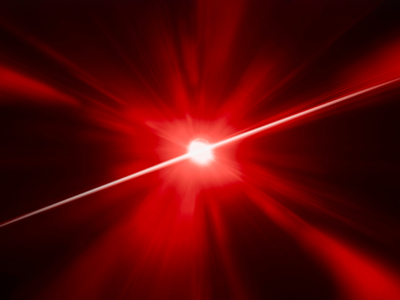
Ask the AI Tutor
Need help with Light - Other Applications of Light? Ask our AI Tutor!
AI Tutor - Lucy
Connecting with Tutor...
Please wait while we establish connection

A laser is useful for cauterising.
Light - Other Applications of Light
Light has many clever uses in GCSE Physics, from fibre-optic communication to medical scanners. This quiz explores important applications of light in modern technology.
1 .
Calculate the refractive index of a medium which has a critical angle of 52o.
1.15
1.27
1.32
1.44
sin c = 0.788, 1/0.788 = 1.27. Refractive index has no units and is always quoted as just a number
2 .
Optical fibres can be used to transmit which of the following?
Light
Electrons
Protons
All of the above
An optical fibre is a bundle of glass fibres of high quality. Optical fibres are very flexible
3 .
Which of the following are examples of optical fibres?
Endoscope
Digital audio optical connection
Telephone exchange coupling
All of the above
Optical fibres have found their way into most parts of our modern day lifestyles now. They are preferred to more conventional methods as they are more efficient and can be made smaller and more cheaply
4 .
Which of the following is NOT an application of total internal reflection?
Endoscopes
Fibre Optic Broadband
Telescopes
Tacky Christmas Decorations!
Telescopes rely on light passing through a series of lenses or reflection off a curved mirror to bring it to a focus
5 .
What is a laser?
A device that generates an intense beam of coherent monochromatic light
A device that generates an intense beam of coherent bi-chromatic light
A device that absorbs an intense beam of coherent monochromatic light
A device that absorbs an intense beam of coherent bi-chromatic light
Coherent means that all the lightwaves are 'in phase' (all their crests and troughs are lined up). Monochromatic means that the light waves in a laser beam all have the same wavelength
6 .
Which formula correctly states the relationship between refractive index and critical angle?
refractive index = 1⁄sin c
refractive index = 2⁄sin c
refractive index = 1⁄2 sin c
refractive index = 2⁄3 sin c
Different transparent media have different refractive indices
7 .
What is the normal range of sight for a human eye?
25 cm to infinity
5 cm to infinity
10 cm to infinity and beyond
25 cm to about 1 m
As you get older, the near point (the closest point to your eye that is in sharp focus) usually increases which is why you may see older people holding things further away to read what is written
8 .
Lasers can be used for a variety of applications. Which of the following are lasers useful for?
Cutting
Cauterising
Burning
All of the above
The strength of the laser should be considered when dealing with each situation, as some may require stronger lasers than others
9 .
What is the definition for critical angle in optics?
The angle below which total internal reflection occurs
The critical angle is the angle of incidence above which total internal reflection occurs
The angle between the normal and the angle of incidence
The angle between the normal and the angle of refraction
Total internal reflection is the reason that glass fibres can be used to transmit light efficiently from one place to another
10 .
What is the critical angle of a medium if its refractive index is 1.5?
40o
41.8o
50o
51.8o
Rearrangement of the refractive index equation
**Unlimited Quizzes Await You! 🚀**
Hey there, quiz champ! 🌟 You've already tackled today's free questions.
Ready for more?
Ready for more?
🔓 Unlock UNLIMITED Quizzes and challenge yourself every day. But that's
not all...
not all...
🔥 As a Subscriber you can join our thrilling "Daily Streak" against other
quizzers. Try to win a coveted spot on our Hall of Fame Page.
quizzers. Try to win a coveted spot on our Hall of Fame Page.
Don't miss out! Join us now and keep the fun rolling. 🎉
**Unlimited Quizzes Await You! 🚀**
Hey there, quiz champ! 🌟 You've already tackled today's free questions. Ready for more?
🔓 Unlock UNLIMITED Quizzes and challenge yourself every day. But that's not all...
🔥 As a Subscriber you can join our thrilling "Daily Streak" against other quizzers. Try to win a coveted spot on our Hall of Fame Page.
Don't miss out! Join us now and keep the fun rolling. 🎉






